with 🎙️ Kobe Nagar, CEO & Co-Founder at 374Water
💧 374Water is a cleantech company, that builds and develops Innovative physical-thermal technology (Supercritical Water Oxidation – SCWO) for resource recovery from waste and emerging contaminants elimination.
This episode is part of my series on Wastewater Energy. Go check it out! 😀
What we covered:
🥖 How Supercritical Water was discovered 200 years by a French engineer: Charles Cagniard de Latour
⚗️ How substances have a critical point, and where that one actually sits for water
🍏 How water’s physical properties change when we go past its critical point
🍏 How one can leverage these changes to run supercritical water oxidation
🧮 How supercritical water oxidation (or SCWO) works, and what it can deliver in terms of pollutant removal and resource recovery
⚡ The perks of supercritical water oxidation: how fast it goes and which feedstock it works with (spoiler: all of them)
🧪 How the process can be energy positive by tapping into the chemical energy dissolved in wastewater
🍏 The perks of taking time to evaluate options when developing a new tech (and of leveraging previous experiments)
🧱 How Supercritical Water Oxidation draws on simple building blocks available everywhere
🎚️ How scale effects unlock even better energetical mass balances
📺 How SCWO developed since the 1990s (and how some developments were unnecessary complex)
🍎 How challenging it is to introduce a new technology in the Water Industry (and which technologies SCWO intends to replace)
📈 374Water’s business model and recent (external) growth
🚽 Spinning out of Duke University, Bill & Melinda Gates’ “Reinvent the Toilet” challenge, using Celsius instead of Fahrenheit, great French discoveries, being feedstock agnostic… and much more!
🔥 … and of course, we concluded with the 𝙧𝙖𝙥𝙞𝙙 𝙛𝙞𝙧𝙚 𝙦𝙪𝙚𝙨𝙩𝙞𝙤𝙣𝙨 🔥
Teaser: Supercritical Water Oxidation
Resources:
🔗 Have a look at 374Water’s website
🔗 Come say hi to Kobe on Linkedin

is on Linkedin ➡️
Infographic: Supercritical Water Oxidation
Infographic-Kobe-Nagar-374Water-Supercritical-Water-OxidationQuotes: Supercritical Water Oxidation
Quotes-Kobe-Nagar-374Water-Supercritical-Water-Oxidation-SCWO-1Table of contents
- What we covered:
- Teaser: Supercritical Water Oxidation
- Resources:
- Infographic: Supercritical Water Oxidation
- Quotes: Supercritical Water Oxidation
- How does SuperCritical Water Oxidation Work?
- Full Transcript:
- A postcard from… Duke University
- Introducing: Kobe Nagar, CEO & Co-Founder of 374Water
- What is Supercritical Water Oxidation?
- Different oxidants can be used in supercritical conditions
- Is it challenging to work at 374°C and 221 bar?
- Supercritical Water Oxidation’s energertical secret: it is an exothermic reaction
- Why did it almost take 200 years between Supercritical Water’s discovery and SCWO’s first references?
- Supercritical Water Oxidation enables Resource Recovery
- … And eliminates forever chemicals like PFAS!
- Is supercritical water oxidation too good to be true?
- Is SCWO tailored to hard to treat wet streams?
- Innovative business models to speed up the adoption of SCWO
- 374Water is half a unicorn (or a Zebra) as per its latest valuation
- Wrapping up Supercritical Water Oxidation
- Rapid fire questions:
- Other Episodes:
How does SuperCritical Water Oxidation Work?
Here’s a simple process flow diagram to describe how SCWO actually works ⬇️
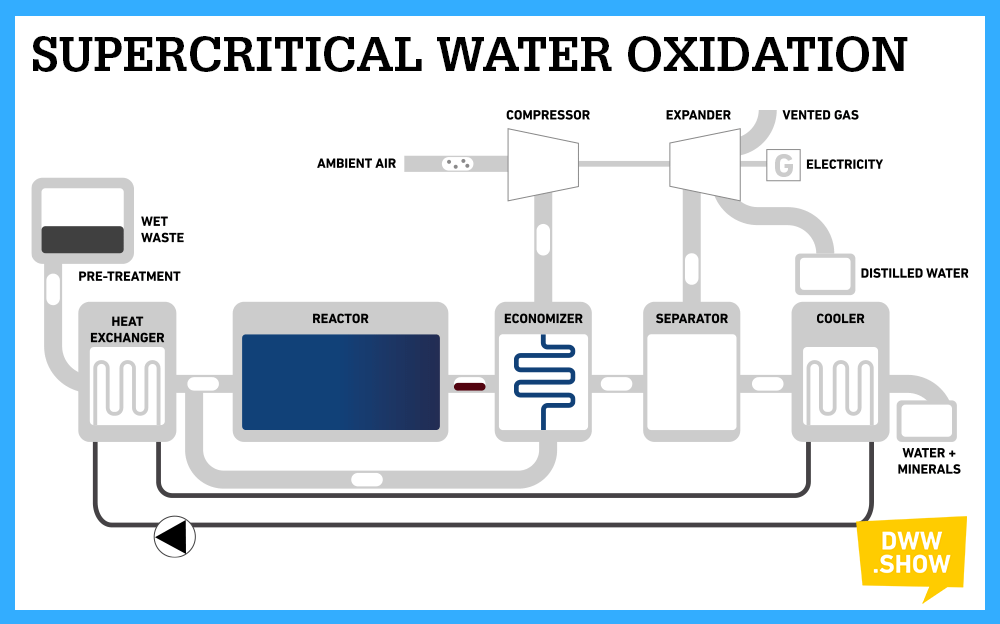
Full Transcript:
These are computer-generated, so expect some typos 🙂
Antoine Walter: Hi, Kobe. Welcome to the show. Hey,
Kobe Nagar: hi. Good to be here.
A postcard from… Duke University
Antoine Walter: Well, we have a fascinating topic on our plate for today, so I have to tell you, I can’t wait to really dive into it, but right before I’m going to start with my good old traditions, which is the postcard. And your postcard comes from North Carolina. Am I right?
Kobe Nagar: Yeah. My postcard comes from Durham, North Carolina, which is the home of duke university. Well, can
Antoine Walter: you tell me about that place, which I would ignore it by now, aside from it’s the home of the duke university.
Kobe Nagar: So first of all, you know, everybody’s familiar with the duke basketball team, but the first thing that I saw when coming here was a lot of trees around.
It’s a pretty green place. I think it’s a really good. Place where you have talent from people from top university, but also the climate to really start and grow, uh, companies in, in the environmental space.
374Water is a Spin Off of Duke
Antoine Walter: So talking of growing a company in the environmental space, that makes a smooth transition. You’ve been a spinoff out of duke university.
So you were a professor at duke university, so. Yeah.
Kobe Nagar: So I was part of duke university. I wasn’t a professor. They don’t let me teach kids because I’m sending them out to do some real work. But I was leading a very fascinating project that we were able to turn into a company. I’ll talk about that and dive intointo that.
Introducing: Kobe Nagar, CEO & Co-Founder of 374Water
Antoine Walter: Before we discuss this adventure, which is going to be our deep dive. Of course, for today, I was trying to find, you know, that the red threads in your path and I’m the best I could find was you into engineering stuff. Sounds like pretty obvious, but also on the unconventional side of things, like really scratching the unknown, would that be a right definition or would you have a better one?
Kobe Nagar: It’s a good observation. You know, if you look in, in retrospect, I was always involved with industry that kind of pushed the envelope of the status quo. So, you know, going back early, early on in my career, like I was fascinated by rockets. Rocket Tyrian was, was the thing that I wanted to do. But you know, after a couple of years in that industry, I discovered that the defense industry is not as glamorous as people think.
And I like to say that, you know, I turn into the bright side of the world of renewable and clean tech. I was very, very fortunate to actually work on your terminal energy and travel the world, see places work on fuel cell energy. And before I joined juke, I was actually in a startup that was doing cement out of CO2.
And I think that can be a separate conversation for. And then, you know, going back to the university and after two years spawn off, spawn off a company spun off 3 74.
The importance of the Bill & Melinda Gates foundation
Antoine Walter: So let’s go back to that point in time where you do that. That’s been enough. What I’ve seen is that there is a link with the bill and Melinda gates foundation at some point.
And what’s the story. What did you, did you find out which was worth spinning off?
Kobe Nagar: So going back to 2018, you know, I was still parked in duke university. I wasn’t a professor, but at that time at the university, we,
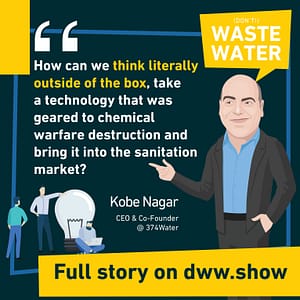
And really to give credit to the foundation, to the bill and Melinda gates foundation, they’ve sparked a lot of new ideas and got people really excited about the wastewater industry and the importance of that.
So, you know, elevating that to discussion level, that’s a big credit to the foundation.
Antoine Walter: It’s very interesting that you mention that because I had Aaron Tartakovsky on that microphone from Epic Cleantec. And he also was one of these spin-offs of the reinventing, the toilet challenge. And it’s a totally different direction than the one you’ve been following.
So it sounds like, you know, it’s an opportunity for many good ideas to go out there and to walk there.
Kobe Nagar: Yeah. Yeah, absolutely. And there is a theory that:
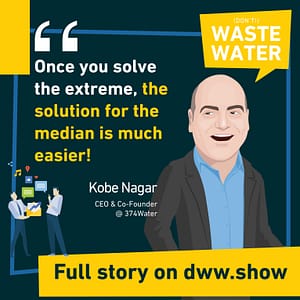
And when we have to come up with a solution that will go into the developing world, you are forced to think differently.
You are forced to think about how you can leverage the entire ecosystem to do what is best for the community. Not just the individual part of how people are thinking about water and wastewater in today’s. Let’s
Why 374Water and not 705Water?
Antoine Walter: dive into your technology and just have the last stop before we do that, your company is called 374water you’re based in the US which to my knowledge work with Fahrenheit and not with Celsius.
I was just wondering, why are you not called 705 water?
Kobe Nagar: Yes, that’s actually a funny thing about that. W we actually had a short debate calling the company 7 0 5 or 3 74 water. And I remember at that time, I was, I was reading an article about movies that have the number three are more successful than other movies.
But to me, you know, frankly, yeah, the us is really big on the Fahrenheit scale. But to me, it was invented just to do a few Northern countries, not be below zero half of the year. So, you know, definitely Celsius makes more sense for engineers.
What is Supercritical Water Oxidation?
Antoine Walter: So actually, as we some spoiled it, the name of your company has something to do with the technology you were developing.
And there was that very special things that happens at 374 degree Celsius with water. If you go also beyond 221 bar, and that is. The critical point of water. And so far, I mean on that microphone, we’ve discussed a lot of technologies and none of them have been to that extreme. So above this 374 degrees and above this 221 bar, which is the super critical phase of water, what happens there and what got you interested in that field of behavior of.
Kobe Nagar: Yeah. So what happened in supercritical water is very fascinating. And let me go back because for a lot of people, when we talk about the technology, and again, if we did talk to the technology. For dummies, you know, another to make it simple, we say that:
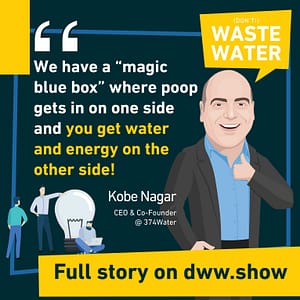
And yes, it sounds very good. But to take it down a notch, we are using this technology called supercritical water oxidation, which sounds very bombastic. Right. But the only thing that people and that’s our job to educate is there are two things that. Warren told in, in school, one of them is everybody’s familiar with the three phases of water being bean, ice, liquid, and steam.
But as you mentioned:
And then what’s really fascinating about it, is that:
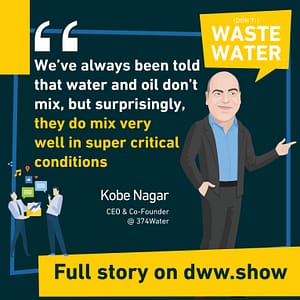
The solvent properties of Water change beyond its critical point
Antoine Walter: So, let me try to understand that that means that you have the normal behavior of water, which is, it is a perfect solvent.
You can mix whatever you want with water and it doesn’t mix with some stuff and pass that super critical point. It’s just the absolute opposite. It does the exact opposite from what he does below. Is that an oversimplification or is that.
Kobe Nagar: That’s exactly it. So the way I look at what a water is, the solvent of life, right?
There are a lot of things. That water is a, is a very basic molecule defy from a scientific perspective. This is another, another reason why water is such an interesting molecule, but it completely flipped.
That creates a very, a very, very unique properties. And the second component of supercritical water oxidation is, is the oxidation. So.
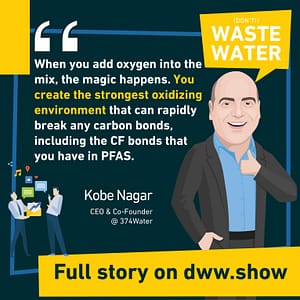
And when I say rapid, I, I mean seconds, you know, we like to say to people that:
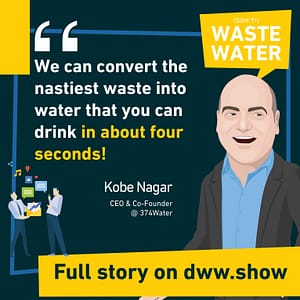
Different oxidants can be used in supercritical conditions
Antoine Walter: we’ll come back to the potential efficiency of your treatments. I just want to understand this oxidation as well. When the student understood you placed at water in this super critical phase, but now you need to oxidize it.
You said you can do it with oxygen. You can do it, I guess, with air, which is 20% oxygen, 80% something else, or you can do it with different kinds of oxygen. And I saw that different takes at the technology on the market and. You are using air.
Kobe Nagar: Yes, that’s a great question on, on the, on the top of Fox oxidant that you can use.
So the oxidation can happen with, with any type of oxidant source and it can be pure oxygen. It can be even hydrogen peroxide or different types of oxygen, oxygen metals. But when we looked at the technology, we were looking on the developing world where, you know, the infrastructure, the grade is, is lacking or doesn’t exist at all.
And we choose to use. Uh, which is readily available, available anywhere. And that decision actually simplified the system and made it a lot safer. And later on, we found some, some really, really other cool benefits of using air. Like what, like, you know, things that are part of our IP portfolio.
Is it challenging to work at 374°C and 221 bar?
Antoine Walter: Just for me to understand here as well, air you fully right.
Makes a lot of sense is everywhere. So you have a compressor and you bring that air inside the system, I guess that makes it much more Kettering to any kind of field steel. You have to bring your water to this 374 degrees, which I guess doesn’t happen on your boiler. And same with the pressure you have to bring it to this 221 bar, is that complex or it’s also something which is pretty rich.
Kobe Nagar: I think it’s, you know, it’s, it’s complex, but it’s also very simple because in different industries, those are things that are being done in a very common piece of equipment. So if you take, for example, your, your diesel engine. You’re a diesel engine is running at a slightly lower pressure, but a much higher temperature.

And it’s all about having the system engineered to withstand that pressure. What really works for our advantage. And this is connected to the hive, how quickly the reaction is happening is the size of the system is very small. So when we talk about the size of our reactor, you know, kind of the heart of the system, we talking about a size of a one leader pair, a thousand people that makes the entire system, you know, very small, very compact, but mostly safe because you don’t deal in with a lot of volumes here.
What is the size and specificity of the reactor needed?
Antoine Walter: You mentioned the reactor as being the central part of your system. What’s special about it?.
Kobe Nagar: Surprisingly nothing special about our, our reactor. I’m saying that from a process perspective, I think, you know, for a lot of people in the field, they, they start to romanticize on a hydrothermal flame that is happening and you capture that.
But, you know, I’m, I’m looking at that as a, as a practical chemical engineer. So I’m looking at that as a chemical reaction. And in our case, we use in what has been called a plug flow, reactor that from a again, volume perspective and cost perspective on the system is a very small and similar ratio to the heart of the, the human body.
So, yeah, it’s, you know, it’s the core piece of our technology, but in terms of size, it’s more and very compare.
A single treatment step (that lasts 4 seconds)
Antoine Walter: So we have water entering. We have. Compressed air entering. Then we have that plug flow reactor where this quite simple technology, if I listen to you, which is mimicking a bit of the body, and then what happens at the outlets, what comes out of that reactor of through these very long four seconds, where we ask inside
Kobe Nagar:
So when we take any type of hydrocarbon or any type of a nitrogen species, we can break it down to the elemental CO2 water. And if you have nitrogenic, it becomes nitrogen gas. And really the end result is you get water, you kept your water, you kept your energy from the exothermic reaction.
And the rest is very nervous, inert gas. So nitrogen CO2 and all the inorganic minerals that were in the waste. And those minerals can be reuse. And in some cases, the values is big there because you have a lot of false.
Supercritical Water Oxidation’s energertical secret: it is an exothermic reaction
Antoine Walter: Just before we go back to that, I think you just correct a word which now explains everything about the energy.
You just said the reaction is exothermic. So that means that you’re producing more heat through the reaction. Then what you have to add at the beginning, hence the system can potentially be energy positive. Is that.
Kobe Nagar: Yeah, well, energy in is energy out, right? You can only lose energy in, in, in that, in that equation. But:
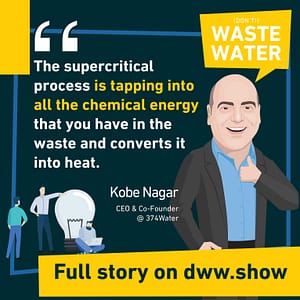
Can the treatment be energy neutral or even positive?
Antoine Walter: What would be the theoretical ratio? 100 person is what you need to just sustain your system to have perfect balance.
How much more could you with scale produce than the energy which you, you, you have as the space level. So we’re talking a 105 persons, 120 person, 700%.
Kobe Nagar: No. So there is, there is a trade off between sizes of equipment and efficiency of equipment. So for example, our smaller scale system is actually designed for 6,000 people.
And under 6,000 people, we still, we are getting close to energy neutral, but there is still a ciliary equipment that needs to be run where we become a producer of electricity is in the first thousands. And again, it all depends. How do you account for that? So w when we talk about the energy positive, we talking about the electricity positive in terms of heat, you’re always energy-positive was because you convert all of that to heat. So:
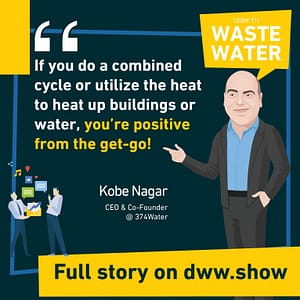
But for most people, when, when they see waste, they’re saying, this is something we get, we need to get through.
On a one-on-one example on a dry basis. you know:
And the supercritical water tradition, we call it SCOW for short. So the SCOW process can tap into that. And to me, you know, that was the reason I was drawn into this field from the first place.
I was looking at that as energy as an energy solution. And the challenge for us was how do we simplify the system and make it a user-friendly and ultimately autonomous.
Antoine Walter: But that thread, let me continue that one. You said that the technology has been invented by the French. Hey, in 1822, did I get that one?
Kobe Nagar: The concept of supercritical water was discovered by a French man that I forgot his name.
Why did it almost take 200 years between Supercritical Water’s discovery and SCWO’s first references?
Antoine Walter: I’ll find it. I have to battle for the French. So I’ll put it in the episode notes. Uh, but from what I’ve read in preparing for that episode, I found many research paper around supercritical oxidation or score let’s use score in the nineties, and then there are some tries and you have different companies left and right.
Which are trying, which is usually a good sign because if nobody tries, maybe they know something that you don’t know what’s different about you. That. You potentially be the one which is going to be very successful with it, or which is very successful.
Kobe Nagar: Great question. And then we get it a lot because the technology was tried and invented back in the nineties.
And I think, you know, what helps us be successful is we really took the time. That’s the beauty about starting in a, in an academic Institute. Like we had the real pleasure on looking on what people have done before. And trying to figure out what worked for them, what failed and came up with a hybrid that took the benefit from both worlds.
Uh, you know, again, I give the example of the air. You know, the first system that were developed were based on air and then the second generation that people strive where we’re based on pure oxygen, we were able to take those two thinking group. And figure out a hybrid that is using air, but using some of the elements that the folks that we’re focusing on on pure oxygen we’re, we’re using to me, that that would make us successful.
We had a very, uh, long time of developing the technology way. The pilot that we have at duke university, uh, has been operating from 2015. And it’s all about all about pushing the envelope. The holistic, you know, this is, this is another, another point for the French it’s. If you look back on history and I’m trying to correlate that to the wastewater industry in a lot of sense, what we’re doing in the wastewater industry is very similar to a hot air balloon.
Or the technology that was again invented by, by the French, in the 18 hundreds. Yeah. And then what we’re trying to do is accelerate all of that, then put a jet engine also invented by, by the French about a hundred years ago into this.
Antoine Walter: So you’re working for the French embassy.
Kobe Nagar: Don’t you, I’m getting, I’m getting something out of that, but yeah, you know, if you look on, on technologies and companies in the,
Antoine Walter: Okay. You were positive so far and you had to be also realistic itself.
Kobe Nagar: It’s all about the balance view.
Supercritical Water Oxidation enables Resource Recovery
Antoine Walter: So, absolutely. I’m sorry, because I’m dragging you a bit around, but I’ve cut you off when you were explaining the resource, because you said there are three pillars, there’s the water elements, there’s the energy element.
And there is the resources and the recovery of those resources, which is the third pillar of what you explained. And I cut you off when you were starting to explain that. So I like to get that part of the story. How do you recover those resources, which you have been successfully separating from water and one of the streams which you can generate with.
Kobe Nagar: The first resource that we recover is water. So we can,
And that’s the first thing in our system. What you get is half of the water is, is a distilled water quality. And then the other half is water that contains all the minerals. And it’s all a matter of the market drivers about the value of those minerals.
Recovering those. I mentioned the fact that for municipal sludge phosphorus is about 10 to 15% of those minerals and it’s, it’s very easy to recover. And on top of that, the entire mineral stream can be used as a fertilizer as.
… And eliminates forever chemicals like PFAS!
Antoine Walter: So you have this resource recovery element, which allows you to drag the water and the resources.
We also just touched on the efficiency of the removal that you have with your system. And you said it can break even PFS. And I’ve seen in one of your case studies that you are breaking down PFS 2 99 pound 98 or 99%, which sounds impressive. Is it something which is true for any kind of feed or. Do you have to have specific conditions for that to happen.
Kobe Nagar: So when we look on the process, we say our processes it’s feedstock agnostic. It doesn’t really matter which kind of hydrocarbon you’re fitting in. It can be fecal matter, frequent sludge, but it can also be any other organic like plastic or those molecules. At the end of the day, it’s a molecule that has a carbon bond, but you can break and get energy from breaking down.
The same way that you burn natural gas. What’s really unique about it is you do everything in a media water. You know, we go back to the fact that the water is the solvent of life. So:
And that’s very important because one of the biggest challenge of destroying eliminating P for us in incinerators is at the end of the day, you get HF or hydrofluoric acid. Which is bad for the equipment, but also also bad for the environment in our case. What you end up with is fluoride, usually calcium fluoride, which can actually be beneficial used, like this is the type of chemical that you have in your toothpaste.
Is supercritical water oxidation too good to be true?
Antoine Walter: Okay. So you’re treating water with a high efficiency. You are potentially energy positive, but you allow resource recovery, you use stuff which is available everywhere, heats and pressured air. I’m looking for a caveat. You know, that sounds really too good to be true. So please, can you give me one limitation or one drawback to your system?
Only one.
Kobe Nagar: It does sound too good to be true. And you know, when,
I think what we’re doing is all about managing, managing the stream in managing the stream out.
And, and this is, this is where we had to think about really, how can you feed. Uh, very viscous sludge into our system. So it took us several tries to figure it out.
And it took us some years to figure out what’s the right heat exchanger to use and how we can do that.
And, um, as you mentioned, you know, back in the nineties, The biggest challenge with supercritical water oxidation is the fact that reactors and the materials for their reactor were pretty limited. And you had problems with corrosion. And then we mentioned the phenomenon of supercritical water that it’s not great solvent for inorganic.
So you had plugging issues. So we had to work really hard around those issues and how to solve. Right now the biggest challenge is adoption in the market. You know, we know that the water industry is very risk averse. We have a saying that:
You know, it doesn’t matter if you’ve done it over and over again. Everybody thinks that their waste is a unique snowflake and you have to try it again. And again, the reality is we don’t right. And that’s something that we’re trying to change in the industry. Doing a custom design that is a copy paste from an under design.
We’re trying to say, this is our system. It’s been mass-produced and this is the way you operate that. And it kind of simplified the process.
How to deal with the new technology adoption curve
Antoine Walter: Talking over this adoption curve, which is, as we all know, one of the major herders, you know, our industry and we can debate it because it’s probably also for good reasons, not only for bad reasons, but what is your intended application?
What is the part of the industry where people are dying to get your solution?
Kobe Nagar: We mentioned the fact that the solution is very feedstock agnostic. So what we’re catering is not just the utility, not just the municipal side, but we also taken care of on the industrial waste. Uh, right now we are focusing on a sludge and biosolids treatment because it’s a big issue from a cost perspective, but also from emerging contaminants.
And before, uh, you know, a lot of folks talking about before solution, but they’re basically talking about removing PFAS. I think we are one of the only companies that are talking about elimination.
Antoine Walter: It’s not separating the PFS, it’s breaking them down and eliminating them.
Kobe Nagar: Yeah. It’s actually moving them out of our ecosystem, breaking them down completely.
We tend to joke that a lot of folks are doing basically . That is really pushing the problem to another location or, or, or the next generation. And we’re saying, no, let’s think about how we can solve it. And, and, and there are some synergies, for example, when you treat biosolids affinity to biosolids. So when you take and treat biosolids, you’re taking about a thousand more people, Smalley, pure.
Then water. So, you know, you take that out of the environment. And I would say, you know, our solution is in the, in the business of minding pollution and taking the beneficial part of that.
Is SCWO tailored to hard to treat wet streams?
Antoine Walter: But again, does that mean that the first place to use your technology is if I’m dealing with a complex problem and you’re probably the best, most trap.
To a different, totally different scale because you’re not just trapping the pollution. You’re reducing it. Mineralizing it. And just eliminating it, but just do know the benchmark. What is the portion of the water industry you intend to disrupt and replace to use the big words?
Kobe Nagar: Yeah. So, so right now, you know
Innovative business models to speed up the adoption of SCWO
Antoine Walter: So if you’re lower OPEX, lower CapEx and your, you have a difficulty for the early adopters. I want to be the first because everybody wants to be the second first to be second.
What is your business model? There is it to sell your containers? Is it to offer them as a service to rent them or to deliver a treatment of water as a service? What is your model right now?
Kobe Nagar: Our job is, is basically reducing barriers to the industry. And this year we, we are actually going to offer both, provide them as an equipment sale, but also provide service.
What’s really unique about our solution is you can relocate it just because it’s small it’s containerized that actually opens up another possibility of leasing in our equipment. So instead of designing your plan for the next 30 years, you only need to design it for the next six months until we can deliver another, another module.
Or if you have excess capacity, you can rent it out or move the entire asset to a different location. So it’s open, opens up new and innovative business models around waste treatment
374Water merged with PowerVerde to leverage synergies
Antoine Walter: Talking of new innovative business model. I just saw that. Um, I mean, when I was preparing for our discussion, I saw that you merged with PowerVerde, which from the name has or inside.
So I think that has to do something to do with the poor generation or something around power, which sounds to me like a way to extend the business model and to say there’s also the power element, but really that is my helicopter view from the other side of the Atlantic. So when was the, the idea with this.
Kobe Nagar: Yeah, thank you. You’re right on point, you know, for us, it was simple, a good alignment of the businesses at that time. Uh, PowerVerde were our supplier for the energy recovery piece. So, you know, think about the, the super critical oxidize. We make a lot of heat, right. And we need to convert that heat back to electricity.
So that’s why we, we needed, uh, an energy recovery system. And that’s what poverty had at that time. And we, we learned to, you know, work with each other and then, and then said, let’s figure out a way that we can merge and the, or is also been publicly traded. We wanted to use that vehicle to raise. So we were successful in, in merging, but also raising money for the merged business together.
374Water is half a unicorn (or a Zebra) as per its latest valuation
Antoine Walter: So that is a field, which is of course fascinating, but I was just reviewing the numbers before we discussed. So your public listed and if I’m right, you’re half a unique.
Kobe Nagar:
That’s essentially what we’re gearing gearing to do. So, so we want to be in those areas, we are connecting the technology into the water and waste and energy, and then the backend, the mineral and the heat is perfect for food production. So we go to be and connect those four communities in a, in a more decentralized ways that than what’s what’s exists out there.
Antoine Walter: That’s an interesting vision. Does that mean that you might have more in the pipe because we’ve seen that in terms of scope, the fact that now you are together with polar Verde allows you to have everything which is inside the container basically is yours, but we could imagine that on that decentralized, distributed scale on the agriculture or the food side of things, maybe you can also valorize these minerals that you gather and also transform them within one.
Potentially subsidiary. Is that something which, which makes about sense or so you really focus on what you do best and then you deliver the best components to the next.
Kobe Nagar: We have to focus, right? That’s the challenge for, uh, for a company we have to focus about our core technology, but what’s, what’s the strategy for us, you know, on, on growing the business and growing that concept that, that waste isn’t is the ultimate reason.
Is to create a bolt on technology that will come and provide that vision to again, decentralized solution that will cater the needs on water, waste, energy and food. So we’re not going to do it ourselves. We have, you know, an M and a strategy and partners that we work with.
What’s the growth outlook for 374Water?
Antoine Walter: If I look on the horizon, what are the triggers, which will help.
Grow even faster, because you said you took your time, but I would debate that because if you did your first pilot in 2015, I mean the usual timeline for a company in this water industry is to take 15 to 20 years to be in the middle of the market. You took five to seven years to be hauled for unicorn.
I’m debating the fact that you were going slow and I’m rather seeing that as you’re, you’re going pretty fast, but I would see different triggers that could help you. If we say the water industry has to decarbonize. Then the fact that you were energy positive and that you’re not producing methane is very positive for you.
If we start to go into resource recovery and we build the resource recovery routes while you’re the perfect feedstock for those resource recovery routes. So what is the, what is your future driver? Trends that you can write to grow.
Kobe Nagar: It’s definitely fascinating, right? Everything. And in order to be successful, you have to have the perfect time.
It’s all about timing in, in, in business. And luckily for us, you know, we are in four of the, of the critical element in, in the water industry right now. So, you know, last year we were in WEFTEC. And one of the big questions that we had with the organizer is where to put the 374 books, because we want the innovators of last year, we are focused on this centralized solution.
We are focusing on . And we are focused on, on resource recovery. So, you know, you kind of answer four of those buckets in, in the company. And the market is, is really, really first the four solution that can look at that from a moralistic perspective. And I believe that that super critical work sedation is, is, is the key to achieve.
Where will the company be in 5 years?
Antoine Walter: Now last question for me in that deep dive, you know, have my crystal bowl next to me and you can look in my crystal ball and it’s, it shows you where a 374 water is in five years. What tells you that you’ve succeeded when you look in that crystal?
Kobe Nagar: And again, it’s about targets that we put in, in front of us.
So, you know, the targets that, uh, that we put for last year is to sell two units. And for this year, we are actually going and selling 10 units and that’s the target for this year. So it’s all about pushing the company forward. You know:
Wrapping up Supercritical Water Oxidation
Antoine Walter: Well, I think that makes for a perfect tour of supercritical water oxidation and of what makes you special in that field, which is bubbling. And I have to say that you were on my bucket list of in VTS. People I wanted to have as a guest, but also your name came regularly from suggestions. So it’s not like I’m the only one who wanted you to be on that microphone.
So it sounds like you’re onto something it’s not everyday that I get to guest, which is requested by the audience. So. I think that’s assigned seats as you wish, but that’s a sign. I
Kobe Nagar: appreciate that. Yeah. We really try to do good in this, in this world, you know, going back. And I think, you know, one of the questions that people are.
You know, asking is why did you create this? Why, why are you going against the giants? And it was mostly because the giants didn’t want to develop technology. You know:
And when I saw that, I said, you know, something needs to be done in, in this world. On my kids and I want them to have clean drinking water. And right now the solution that we have in the industry or are limited. And:
The importance of R&D
Antoine Walter: Actually what you see on R&D makes me think of what Paul O’Callaghan was explaining on that microphone. When we were discussing his stages on the dynamics of water innovation, I was asking him because in his fears it shows that there’s only a fraction of the companies which really invest into and.
And to me, that’s not obvious. I thought all the companies are investing in R and D, but it’s not the case. And what he was seeing is he wasn’t blaming them at all. They were saying, it’s all a matter of return on investment. If you can prove that investing so much in RNG brings you so much and a bit more than everybody would do it, but it’s about having them the right scale, the right fields, the right ideas.
So that’s what you invest has a clear output in a sizable. Timeline. And from what I understand from 3 74 water, that’s probably your chance there is that you’re looking at a scale where you can see the effects pretty fast. You’re surfing a wave, which is a tidal wave. I mean, what I mentioned about the resource recovery and the decarbonization is there to stay.
And what you mentioned about the food, water, energy nexus, I mean that clearly is also here to stay so that places. You know, if you’re tracing a Venn diagram at the center of that Venn diagram and it’s I guess, a good place to be in. And I’m pretty sure you’re not there by accident either. So
Kobe Nagar: yeah. Well, you know, sometimes something you need a little bit of luck to be in that.
Specific Venn diagram, but luck is on our side. I think from being in the industry, seeing people, I think everybody in the industry, people are great. You know, there are people that really care about the environment, people that want to do good. And it’s all about recognition. You know, I think the big companies are really challenged or facing failures.
And if you don’t, if you take risk, you might have. And, uh, and that’s something that, you know, mentally needs to be changed.
Because you need to advance society forward.
And unfortunately, you know, we weren’t really. Picking the pace on water and wastewater, and that’s going to change. It’s going to change from people know and want to know more about water.
So how do we have a similar industry, the power industry, that every product you buy, you know, how many kilowatts it consume, you know, how much it’s going to cost you for a year.
And it’s, it’s part of the decision process. And electricity comes in one flavor, water comes in many flavor, you have different contaminants and people are not really aware of. And that’s part of our job is to educate, educate the industry and really elevate the value of water. We treated as a, as a subsidized resource that is there.
But the reality is very far from that. The quality is not there. And, uh, I always tell people, you know, the water quality, for example, in, uh, in Michigan can be worse than what you, what you will find in Ethiopia. That’s something that, that needs to be.
Antoine Walter: I fully agree. I fully agree, but unless you have two more hours, I’m not opening that sidetrack because that is a fascinating, fascinating sidetrack.
And the auditors of that podcast know that I can rent quite long about it. So I’m, I’m cautious of your time, but it take a note that that should be, uh, an old. Secret episode at some point to discuss the value of water and the way we tell the stories of water and how we promote it. Because if people value its rights, it’s also a huge business opportunity which has created, and which is a win-win for society.
But I said, I’m not opening can rent. So I propose it to switch to the rapid fire questions.
Rapid fire questions:
Antoine Walter: So in that last section, I’m going to ask two short questions, which you can answer with short answers and you’ll see that I’m the one site tracking. My first question is what is the most exciting project you’ve been working on and why?
Kobe Nagar: Yeah, I would say my kids are the most exciting project that I was, I was working on, but you probably ask them the business world business world definitely, you know, 3 74 is, is a miracle.
And it’s all about how you. Transform and dream into a reality. Can
Antoine Walter: you name one thing that you’ve learned the hard way,
Kobe Nagar: um, that it takes a long time for people to see and understand your alternative universe and vision, you know, for us, the 3 74, it took us almost two years to get the investor behind it.
Antoine Walter: Is there something you are doing today in your job that you will not be doing in 10 years?
Kobe Nagar: I would say, hopefully not work on the weekend, but, uh, you know, it’s a wishful thinking for an emergent company. I get you. I think it’s more of a binary, right? You either get bought out and, uh, and retired or work as hard as you can.
Antoine Walter: What is the trend to watch out for in the water sector?
Kobe Nagar: I think again, maybe I’m a little bit biased, but having those couple. Uh, ideas around water waste, energy and food. And again, this is, this is something that I’m seeing. I hope that more people will see it.
Antoine Walter: If you were a word political leader, what would be your first action to influence the fate of the World’s Water Challenge?
Kobe Nagar: I would say, first of all, listen to scientists. Right? Listen, listening is a good action to do, but mainly kind of incentivize companies to sprout new ideas and innovation. How would you do. So part of that, we talked about, you know, how much of your revenue needs to be allocated for R and D.
I would want to put some kind of legislation that will force you to do that. I’m coming from the mindset of, I was born and raised in Israel and Israel is doing a lot in R and D. So a lot of the revenue, a lot of the reason companies are, are, are created and growing is because you invent in inventing.
Antoine Walter: It sounds like a good program.
I would be voting for you as a word political leader.
Kobe Nagar: Thank you. One toilet at a time. Yeah.
Antoine Walter: Last question. Would you have someone to recommend me that I should definitely invite on that microphone?
Kobe Nagar: That’s the one that might be, might be hard for you, but I would want you to interview, you know, the head of the APA Michael Regan.
And get his perspective about what needs to be done in the sector from a regulatory perspective.
Antoine Walter: Sounds good. I mean, when you said it would be hard, I was hoping you wouldn’t recommend me bill gates, because that’s, I can tell you it’s going to be really impossible for me. I can try, but also suggestion.
Thanks. Yeah.
Kobe Nagar: Well, you know, okay. We’ll talk about it offline.
Antoine Walter: Well, if you have his phone, I can take it.
Kobe Nagar: We have like three tiers below it, but I think, uh, you know, if the right proposal will come like a
Antoine Walter: interesting, you got me hooked. Well, Coby has been a pleasure. Thanks for sharing all of that with us today, I’ll be watching closely the next path of your route.
I mentioned. Half a unicorn, lets you build the other half and then probably we have something to celebrate on that microphone.
Kobe Nagar: Yeah, that’s let’s do it again. Our goal is, is not becoming a unicorn. Our goal is to become a big company that really connects those, those dots and offer something, something else to the world.
But we will celebrate. You mentioned your,
Antoine Walter: your bias and that is my bias and trying to see unicorns everywhere. And maybe it’s because I have two daughters. I don’t know what’s if there’s a link, but, uh, you know, my partner in crime bureau called me a unicorn hunter. So it’s good because, um, I’m hunting something which doesn’t really exist.
So I’m still a good guy, but. Yeah. Anyways, I’d be happy to have you again. So thanks a lot.
Kobe Nagar: Absolutely. It was a pleasure. Thank you. Thank you very much. And keep doing what you’re doing. It’s a big part of educating the audience and, uh, this is what we need in order to attract.

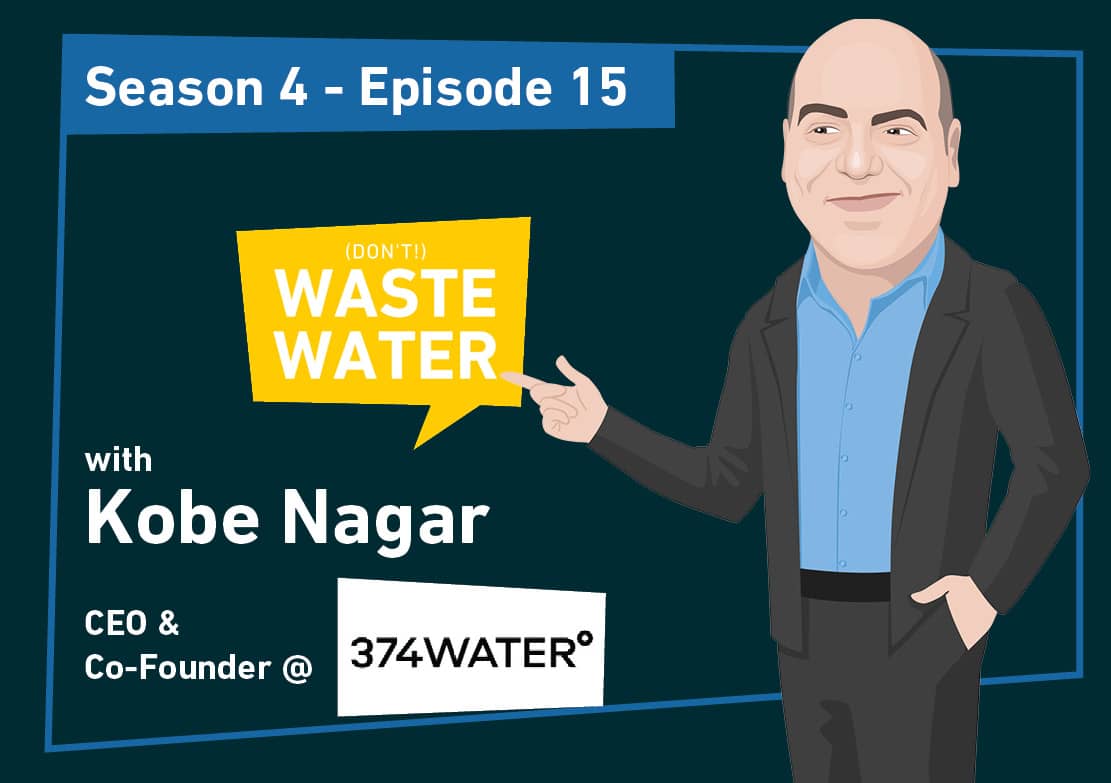











4 thoughts on “Is Supercritical Water Oxidation a Solution for PFAS, Energy (& More)?”